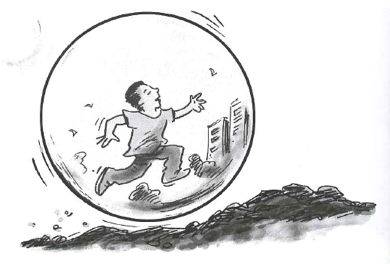4 Managing for emergence and self-organisation
Self-organisation is the phenomenon associated with a system distinguished by an observer, which is able to construct and change its own behaviour or internal organisation. Computer simulations have shown, for example, the behaviour of a flock of flying birds can be understood from a few simple rules, which, if changed, results in the emergence of new patterns of behaviour. When applied to human activity, other features of self-organisation require attention. Self-organisation is also sometimes considered as the acquisition of variety by a system or the progressive emergence of novelty when removal of constraint or control releases capacity for autonomous action.

This perspective, it is claimed, builds on the study of non-linear feedback networks, complex adaptive systems and what Stacey and his colleagues now call 'complex responsive processes'. Stacey et al. (2002) say:
We seek to understand Complex Responsive Processes of relating… [as a process of personal transformation]. This means, for us, that the relational processes of communication, within which people accomplish joint action, are actively constructing the future as the living present and that [the] future is unknowable in advance. Throughout, the process is characterized by the paradox of the known-unknown and in it emerges the aims people formulate, the goals they set, the intentions they form and the choices they make. What is being expressed here is individual and collective identity at the same time.
An important notion from Stacey's perspective is that system and environment co-evolve; it is not a case of a system adapting to its environment. So what might managing be in this context? Patricia Shaw (1996) refers to consultants who operate from a complexity perspective; in contrast to what she claims is a traditional perspective (see Table 1).
| The consultant with a traditional perspective | The consultant with a complexity perspective |
| Designs and implements an educational strategy to realise planned change intended to improve the organisation's position in its environment. | Stimulates conditions of bounded instability in which the organisation co-evolves with its environment through self-organisation. |
| Understands organisational change in terms of temporary transitional instability between system-wide stable states. | Understands change dynamics as unfolding in the ongoing tension between stability and instability in which islands of order arise and dissolve. |
| Contracts to deliver a pre-determined objective or outcome. | Contracts for a step-by-step process of joint learning into an evolving and unknowable future. |
| Sees large scale project plans and political and ideological control strategies as useful only in circumstances closer to certainty and agreement. | Dissuades managers from using inappropriate forms of control to manage the anxieties raised when operating far from certainty and agreement. |
| Chooses an effective marginal or boundary position from which to diagnose the state of the system as a whole. | Becomes an active agent in the life of the organisation, by participating in its shadow and legitimate systems to engage in complex learning processes. |
| Tries to create an intended change in people's shared beliefs, values and attitudes. | Seeks to stimulate and provoke conditions in which people's mental models are continuously revised in the course of interaction. |
| Focuses on global, whole system change whether that of groups, individuals or organisations. | Focuses on feedback loops operating at a local level through which activity may be escalated up to system-wide outcomes. |
| Designs and facilitates off-site meetings to develop strategies and plans and build teams. | Intervenes in the ongoing conversational life in organisations in which people co-create and evolve their action-in contexts or contexts in action. |
| Collects data on generic system variables through surveys, interviews and other instruments to feedback the legitimate system. | Invites an exploration of the relationship between the system's formal agenda (what the legitimate system says it knows) and the multitude of informal narratives by which the organisation is working (what the shadow system knows). These feedback loops generate their own outcomes. |
| Emphasises the need for alignment and consensus around clear directions. | Amplifies existing sources of difference, friction and contention, so that complex learning might occur, provided people's anxiety in the face of such learning is well contained. |
Activity 1 Considering contrasting perspectives
Look through Table 1 now and consider the following two questions:
- Could you use these approaches in your context?
- Do the approaches have to be specific to the role of a consultant?
The table is here to provide some triggers to thinking. I am not suggesting either approach is right.
